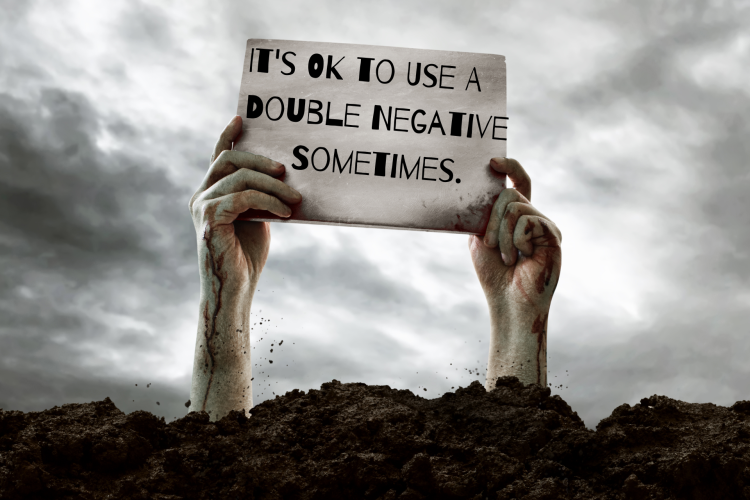Double negatives are supposed to be a bad thing. Using two negatives in one clause is not only ungrammatical, it’s illogical: it creates an unintended positive meaning. According to this thinking, if you say “Studying grammar rules won’t do you no good,” you’re really saying, “Studying grammar rules will do you good.”
Another of those zombie rules we keep trying to kill, “don’t use double negatives” is a rare zombie. Not only is the rule partially correct, but it’s a case of language scolds having won a small victory.
Double Negatives Are Illogical
When the scolds tell us it’s improper to use a double negative (multiple negation to linguists), they aren’t completely wrong. Using a double negative in one clause to refer to one case of negation is considered non-standard English in most instances. In standard English, we need only one negation in the clause to create a negative meaning:
- Studying grammar rules won’t do you any good.
- Studying grammar rules will do you no good.
Yet the argument that the double negative is illogical doesn’t hold up. English used to allow for multiple negation for emphasis, and in rare instances it still can. We shouldn’t wonder why: Negation is often expressed with not or –n’t, and in Old English it was expressed with an equally unemphatic word. If you wanted to get your point across, you doubled or tripled your negatives:
And that no woman has; nor never none
Shall mistress be of it
Shakespeare, Twelfth Night
Over time, the standard became to double the negative. That is, until the 18th-century grammarians got hold of it.
If you’ve been reading my columns for a while now, you’ll know that some 18th-century grammarians were focused on “fixing” English, usually in a manner that made English look more like Latin and always in a manner that looked like their own writing styles. To this day, we’re still undoing some of the damage they’ve done.
In this case, we can’t.
Writing in 1763, Bishop Robert Lowth wasn’t the first to declare that two negatives are illogical, but he certainly was one of the most influential. And his support for saying so? You can’t use double negatives in—you guessed it—Latin. At the same time, literary authors were no longer favoring the double negative for emphasis.
Other grammarians followed Lowth’s lead. They even expanded on the rule, saying that a double negative makes a positive (see below). With fewer examples of the double negative appearing in print and the scolds multiplying Lowth’s advice, the double negative fell out of favor with those who heard the news. In other words, well-educated, literate people.
Some folks never got the message, though, such as speakers of Cockney and, later, African American Vernacular English. Since these dialects are seen as non-standard and their users as universally ill-educated, the idea that a double negative used to state one negative idea is wrong stuck.
A Double Negative Equals a Positive
Although the language peevers managed to marginalize the double negative, they only partially succeeded. There are a couple times when we use double negatives in one clause without stigma.
The first we probably take for granted and don’t think of as negation: coordinating ideas. Our coordinating conjunctions, as the name implies, come in pairs, such as either … or and neither … nor. We pair negative with negative, not a positive with a negative:
Mary can neither play the clarinet nor march in formation.
The second instance is when we use negative words to create an underemphasized positive idea. When the scolds said two negatives make a positive, they weren’t completely wrong:
Fanny looked on and listened, not unamused to observe the selfishness which, more or less disguised, seemed to govern them all.
Jane Austen, Mansfield Park, 1814
If Fanny’s not unamused, she must be amused, but by stating this fact in the negative, Austin downplays how amused Fanny was. This understatement is referred to as litotes and is a useful literary device, as long as it’s not overused. Writing that employs too much of any one device can sound hackneyed.
The hackneyed effect can be even stronger in everyday writing and speech. It’s harder to understand a negative statement than a positive one. Everyday writing is meant to be easily understood, and a double negative can slow down comprehension. Yet even everyday language can support a little litotes now and again. Just use it sparingly.
Knowing that, we can rewrite the rule to slay the zombie:
Don’t use double negatives in one clause to represent one negative idea when using standard American English. Also, use a double negative in one clause to create a positive sentiment only sparingly.
A version of this article originally published on September 8, 2014, on Virtual Thesaurus.


